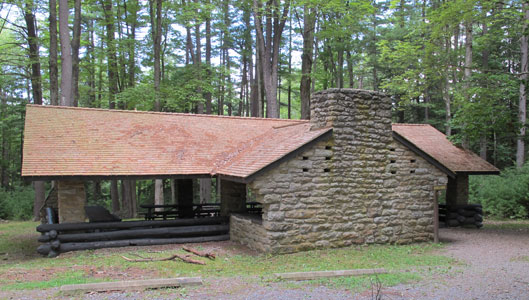
COLTON POINT STATE PARK, Penn. — “Sacrifice our water? No fracking way!” I found this slogan inked on the wooden fence of a scenic overlook point in Colton Point State Park, perched on a slope above Pine Creek in the Pennsylvania Grand Canyon and sitting squarely atop one of the world’s richest natural gas deposits, the Marcellus Shale. ‘Fracking’ refers to hydraulic fracturing, where chemical-laced water is pumped into the earth at high pressure to break the friable stone that holds the gas.
A broad people’s movement against fracking is coalescing in small farming communities across Northeastern Pennsylvania. Few of these towns are without some sign of the gas industry, whether a drilling rig, the scar of a buried pipeline, or simply the ubiquitous trucks of Chesapeake Energy, the major operator in the region. Equally few, however, are without some sign of protest: an inked slogan, a yard sign, perhaps a church billboard with a prayer for the preservation of clean water and untainted farmland.
The movement is inchoate yet, still navigating the confusing terrain of boom-time blessings set off by the terror of what might remain when the gas is gone: contaminated streams and aquifers, ruined farmland, and the economic and social desolation of a region whose last resources have been sucked dry.
Some residents are already getting a taste of this bleak future. On April 19, a wellhead in Canton, PA blew out, releasing thousands of gallons of fracking fluid over pastures and into streams and forcing the evacuation of seven families. In an unrelated incident a month later, the Pennsylvania Department of Environmental Protection fined Chesapeake Energy $900,000 because improper well casing and cementing had allowed gas from some wells to seep into groundwater.
People now realize that such is the price, on credit, of the gas rush that has enriched landowners, brought an infusion of cash into small businesses, notably in the hospitality and construction industries, and lowered official unemployment in my home county of Bradford (where the Canton blowout happened) to 5.8 percent, down from 6.6 percent a year ago and well below the national average.
Colton Point State Park is a particularly apt place for meditation on alternatives to the lopsided, boom-and-bust capitalism of the gas rush. In addition to stunning views and free, well-maintained campsites, the park features a number of beautiful stone picnic pavilions, the work of the Civilian Conservation Corps during the Great Depression of the 1930s.
The CCC was one of the most successful employment programs in our country’s history because it was founded on the idea that government could serve the public interest by employing workers to produce for the public good. The parks, trails, and campsites built by the CCC stand as monuments to the political vision of the New Deal, and to the power and courage of the working class movement that made such a vision achievable.
That courage is not dead. As right-wing attacks on the environment and workers’ rights escalate, a new coalition of labor and progressive forces is gaining ground and finding its political voice. Congresswoman Jan Schakowsky (D-IL) has recently authored a bill to create 2.2 million new jobs in a School Improvement Corps, a Health Corps, a Community Corps, a Child Care Corps, and Neighborhood Heroes Corps. The bill also provides for a Parks Improvement Corps, which would employ 100,000 young people, ages 16-25, to maintain and improve our recreational and scenic resources, places like Colton Point State Park. These programs will put Americans back to work for the public good and provide them with the income they need to stimulate our flagging economy.
Colton Point and thousands of public parks like it are more than recreational areas. They are urgent calls to recapture the political will behind the Civilian Conservation Corps. They show us a vision of an America that did not entrust the public welfare to a handful of profit-hungry corporations.
They teach us, in the midst of gas booms, real estate bubbles, and the whole apparatus of crisis-wracked capitalism, that economic renewal is an illusion as long as its benefits are restricted to a few privileged shareholders, landowners, or businesspeople. The sturdy stone pavilions at Colton Point are monuments, but not only to the triumphs of a past age. They are monuments to the future, beacons on the hilltops of a better world that is just now, once again, coming into view.
Photo: One of the beautiful stone picnic pavilions built by the CCC. Scott Hiley/PW









